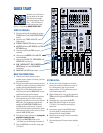
13
PRE FADER
The aux send rule of thumb: For parallel
effects processing, use aux sends in post-fader
mode. For stage monitors, use pre-fader mode
(see diagram below).
With this switch disengaged (up),
AUX 1
and
2
receive signals in post-fader mode: post-
low cut, post-insert, post-EQ, post-mute, and
POST-fader. Any changes made to the channel
controls will affect the
AUX
signal.
With this switch engaged (down),
AUX 1
and
2
receive signals in pre-fader mode: post-low cut,
post-insert, post-EQ, post-mute, and PRE-fader.
Any changes made to the channel controls,
EXCEPT the fader, will affect the
AUX
signal.
In pre-fader mode, you can take the
drummer’s vocals out of the main mix by turn-
ing his fader down, but since he still hears
himself in the monitors, he’s happy.
EFX 1 (EXT)
EFX 1
, designed for feeding the inputs of
parallel effects devices, behaves exactly like an
AUX
send, but it’s always in post-fader
mode: Any changes made to the channel controls
will affect the
EFX
signal. The
PRE FADER
switch has no effect on the
EFX
sends.
EFX 2 (INT)
EFX 2
is identical to
EFX 1
with one big dif-
ference: In addition to feeding the
EFX SEND
jacks, it also feeds the inputs to the
EMAC
EFFECTS PROCESSOR
. If you’re using
EMAC
and just one outboard processor, patch
the outboard processor via
EFX RETURN 1
. You
can use
EMAC
and an outboard device via
EFX
2
; just remember that the sends (
EFX 2 (INT)
,
EFX 2 SEND
) and returns (
TO MAIN
MIX
) control two devices. The
PRE FADER
switch has no effect on the
EFX
sends;
they’re always post-fader.
EQ
The CFX Mixer has low shelving, mid peak-
ing, and high shelving EQ. “Shelving” means that
the circuitry boosts or cuts all frequencies past
the specified frequency. For example, boosting
the
LOW EQ
knob boosts bass frequencies at
80Hz and below. “Peaking” means that only a
selected “hill” of frequencies surrounding a
center “hilltop” frequency is affected by the
EQ control.
Everything in moderation (including mod-
eration): with EQ, although you can bring
a sound to life, you can also screw things
up. If you max the EQs on every channel,
you’ll get mix mush, not to mention driving
your mix levels near or beyond clipping. So
equalize subtly; use the left sides of the
knobs (cut) as well as the right (boost).
HI EQ
This control provides up to 15 dB of
boost or cut at 12kHz and above, and it is
also flat at the detent. Use it to add sizzle
to cymbals or an overall sense of transpar-
ency or edge to keyboards, vocals, guitar,
and bacon frying. Turn it down a little to
reduce sibilance or hide tape hiss.
MID EQ
Short for “midrange,” this knob provides 15
dB of boost or cut, also flat at the center detent.
Midrange EQ is often considered the most
dynamic, because the frequencies that
define any particular sound are almost
always found in this range. You can create
as many interesting and useful EQ changes
by turning this knob down as well as up.
The mono channels employ a semi-
parametric mid-sweep EQ. In addition to being
able to set the amount of boost, you can “aim”
that boost at a specific frequency; anywhere
from 100Hz to 8kHz.
The stereo channels employ a 2-stage fixed-
frequency
MID EQ
.
HI-MID
is centered at 3kHz;
LOW-MID
is centered at 400Hz.
LOW EQ
This control provides up to 15 dB of boost or
cut at 80Hz and below. The circuit is flat (no
boost or cut) at the center detent position.
This frequency represents the punch in bass
drums, bass guitar, fat synth patches, and high-
testosterone male singers.
When adding boost to the channel’s low EQ,
simultaneously engaging the
LOW CUT
switch can create an audible low frequency boost
without boosting stage rumble, mic handling
clunks, and breath pops.
20
Hz
100
Hz
1k
Hz
10k
Hz
20k
Hz
–15
–10
–5
0
+5
+10
+15
20
Hz
100
Hz
1k
Hz
10k
Hz
20k
Hz
–15
–10
–5
0
+5
+10
+15
20
Hz
100
Hz
1k
Hz
10k
Hz
20k
Hz
–15
–10
–5
0
+5
+10
+15
Mid EQ
Low EQ
Hi EQ
TRIM
INSERTLO CUT
EQ
GAIN
(FADER)
PAN
1-2
3-4
AUX 1
PRE-POST
"POST"
SIGNAL
"PRE" SIGNAL
AUX 2
INPUT MUTE
TO AUX 1 MASTER SEND LEVEL
TO AUX 2 MASTER SEND LEVEL
TO EFX 1 MASTER SEND LEVEL
TO EFX 2 MASTER SEND LEVEL
EFX 1
EFX 2
“Pre vs. Post” Auxiliary
Signal Flow Diagram
MID
400Hz
LR
PAN
MUTE
17-18
ASSIGN
LOW
12k
HI
HI
MID
3k
80Hz
LOW
EQ
U
+15
-15
U
+15
-15
U
+15
-15
U
+15
-15
Stereo Channel


















